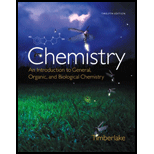
Determine whether each of the following chemical equations is balanced or not balanced:
a.
b.
d.
Want to see the full answer?
Check out a sample textbook solution
Chapter 7 Solutions
Chemistry: An Introduction to General, Organic, and Biological Chemistry (12th Edition) - Standalone book
- Consider the balanced chemical equation :math>A+5B3C+4D en equal masses of A and B are reacted, which is limiting, A or B? Justify your choice. If the molar mass of A is greater than the molar mass of B, then A must be limiting. If the molar mass of A is less than the molar mass of B, then A must be limiting. If the molar mass of A is greater than the molar mass of B, then B must be limiting. If the molar mass of A is less than the molar mass of B, then B must be limiting.arrow_forward(a) Butane gas, C4H10, can burn completely in air [use O2(g) as the other reactant] to give carbon dioxide gas and water vapor. Write a balanced equation for this combustion reaction. (b) Write a balanced chemical equation for the complete combustion of C3H7BO3, a gasoline additive. The products of combustion are CO2(g), H2O(g), and B2O3(s).arrow_forwardHow many molecules of the sweetener saccharin can be prepared from 30 C atoms, 25 H atoms, 12 0 atoms, 8 S atoms, and 14 N atoms?arrow_forward
- 4.13 For the following reactions, determine the value of x. 4C+S84CS2 mol S8 yields x mol CS2 CS2+3O2CO2+2SO2 mol CS2 yields x mol SO2 N2H4+3O22NO2+2H2O mol O2 yields x mol NO2 SiH4+2O2SiO2+2H2O 1.3103 mol SiH4 yields x mol H2Oarrow_forward3.90 Pyrrole has the molecular formula C4H5N. When pyrrole reacts with O2, the products are CO2, H2O, and N2. Write a balanced equation for this reaction.arrow_forward3.11 Balance the following equations. (a) CaC2(s) + H2O(l)( Ca(OH)2(s) + C2H2(g) (b) (NH4)2CrO7(s) ( Cr2O3(s) + N2(g) + H2O (g) (c) CH3NH2(g) + O2(g) ( CO2(g) + N2(g) + H2O (g)arrow_forward
- For the chemical reaction Sb2S3+6HCl2SbCl3+3H2S write the conversion factor that would be needed to do each of the following one-step conversions. a. Moles of SbCl3 to moles of H2S b. Moles of Sb2S3 to moles of HCl c. Moles of H2S to moles of HCl d. Moles of Sb2S3 to moles of SbCl3arrow_forwardBalance the following equations, and name each reactant and product: (a) SF4(g) + H2O() SO2(g) + HF() (b) NH3(aq) + O2(aq) NO(g) + H2O() (c) BF3(g) + H2O() HF(aq) + H3BO3(aq)arrow_forward4.37 The theoretical yield and the actual yield for various reactions are given below. Determine the corresponding percentage yields. Theoretical Yield Actual Yield Reaction 1 35.0 g 12.8 g Reaction 2 9.3 g 120 mg Reaction 3 3.7 metric tons 1250 kg Reaction 4 40.0 g 41.0 garrow_forward
- A 0.20 mol sample of magnesium burns in air to form 0.20 mol of solid MgO. What amount (moles) of oxygen (O2) is required for a complete reaction?arrow_forwardQuicklime, CaO, is formed when calcium hydroxide is heated. Ca(OH)2(s) → CaO(s) + H2O(ℓ) The theoretical yield is 65.5 g but only 36.7 g quicklime I is produced. Calculate the percent yield.arrow_forwardAmmonia can be formed by a direct reaction of nitrogen and hydrogen. N2(g) + 3 H2(g) 2 NH3(g) A tiny portion of the starting mixture is represented by the diagram, where the blue circles represent N and the white circles represent H. Which of these represents the product mixture? For the reaction of the given sample, which of these statements is true? (a) N2 is the limiting reactant. (b) H2 is the limiting reactant. (c) NH, is the limiting reactant. (d) No reactant is limiting: they are present in the correct stoichiometric ratio.arrow_forward
 Chemistry for Engineering StudentsChemistryISBN:9781337398909Author:Lawrence S. Brown, Tom HolmePublisher:Cengage Learning
Chemistry for Engineering StudentsChemistryISBN:9781337398909Author:Lawrence S. Brown, Tom HolmePublisher:Cengage Learning Chemistry: The Molecular ScienceChemistryISBN:9781285199047Author:John W. Moore, Conrad L. StanitskiPublisher:Cengage Learning
Chemistry: The Molecular ScienceChemistryISBN:9781285199047Author:John W. Moore, Conrad L. StanitskiPublisher:Cengage Learning Introductory Chemistry: A FoundationChemistryISBN:9781337399425Author:Steven S. Zumdahl, Donald J. DeCostePublisher:Cengage Learning
Introductory Chemistry: A FoundationChemistryISBN:9781337399425Author:Steven S. Zumdahl, Donald J. DeCostePublisher:Cengage Learning ChemistryChemistryISBN:9781305957404Author:Steven S. Zumdahl, Susan A. Zumdahl, Donald J. DeCostePublisher:Cengage Learning
ChemistryChemistryISBN:9781305957404Author:Steven S. Zumdahl, Susan A. Zumdahl, Donald J. DeCostePublisher:Cengage Learning Chemistry: An Atoms First ApproachChemistryISBN:9781305079243Author:Steven S. Zumdahl, Susan A. ZumdahlPublisher:Cengage Learning
Chemistry: An Atoms First ApproachChemistryISBN:9781305079243Author:Steven S. Zumdahl, Susan A. ZumdahlPublisher:Cengage Learning





